Page 65 of 98

Operation
58
EJU32901
Operating your watercraft EJU32961Getting to know your watercraft
Operating your watercraft requires skills ac-
quired through practice over a period of time.
Take the time to learn the basic techniques
well before attempting more difficult maneu-
vers.
Operating your new watercraft can be a very
enjoyable activity, providing you with hours of
pleasure. However, it is essential to familiar-
ize yourself with the operation of the water-
craft to achieve the skill level necessary to
enjoy riding safely.
Before operating this watercraft, read this
owner’s/operator’s manual, the Riding Prac-
tice Guide, the Riding Instruction card, and all
labels on the watercraft. Pay particular atten-
tion to the safety information on page 10.
These materials should give you an under-
standing of the watercraft and its operation.
Remember: This watercraft is designed to
carry the operator and up to 2 passengers.
Never exceed the maximum load limit or allow
more than 3 persons (or 2 persons if a water-
skier is being pulled) to ride the watercraft at
any time.
EJU33001Learning to operate your watercraft
Before operating the watercraft, always per-
form the pre-operation checks listed on page
45. The short time spent checking the water-
craft will reward you with added safety and re-
liability.
Check local laws before operating your water-
craft.Operate defensively at safe speeds and keep
a safe distance away from people, objects,
and other watercraft. Select a wide area to
learn in, where there is good visibility and light
boat traffic.
Use the buddy system—operate with some-
one nearby. Scan constantly for people, ob-
jects, and other watercraft. Be alert for
conditions that limit your visibility or block your
vision of others.
Attach the engine shut-off cord (lanyard) to
your left wrist and keep it free from the handle-
bars so that the engine stops if you, the oper-
ator, fall off.
Wear a personal flotation device (PFD). All
riders must wear a PFD that is approved by
the appropriate authorities and is suitable for
personal watercraft use.
Wear protective clothing. Severe internal inju-
ries can occur if water is forced into body cav-
ities as a result of falling into the water or
being near the jet thrust nozzle. Normal swim-
wear does not adequately protect against
forceful water entry into the rectum and vagi-
na. All riders must wear a wetsuit bottom or
clothing that provides equivalent protection.
Such clothing includes thick, tightly woven,
sturdy and snug-fitting apparel such as den-
im, but does not include spandex or similar
fabrics, like those used in bicycle shorts. A full
wetsuit can also protect against hypothermia Maximum load:
240 kg (530 lb)
Load is the total weight of cargo, oper-
ator, and passengers.
UF2C70E0.book Page 58 Monday, November 3, 2008 10:16 AM
Page 66 of 98

Operation
59
(subnormal body temperature) and abra-
sions.
Footwear and gloves are recommended.
Eye protection is recommended to keep wind,
water, and glare from the sun out of your eyes
while you operate your watercraft. Restraining
straps for eyewear are made which are de-
signed to float should your eyewear fall in the
water.
You should grip the handlebars firmly and
keep both feet on the floor of the footwell. Do
not attempt to ride with passengers until your
operating skills are fully developed.
EJU33061Riding with passengers
WARNING
EWJ00541
�Do not apply throttle when anyone is at
the rear of the watercraft. Turn the en-
gine off or keep it at idle. Water and de-
bris exiting the jet thrust nozzle can
cause severe injury. Passengers should
not attempt to board the watercraft if the
operator is applying throttle.
�When passengers are on board, make
sure that they are holding on firmly and
have their feet on the floor of the foot-
well before you start to accelerate.
When 2 or 3 persons (including the operator)
are on board, the watercraft handles different-
ly, and is not as easy to maneuver, therefore
operating it requires a higher degree of skill.
Before attempting to operate the watercraft
with passengers on board, the operator must
practice operating the watercraft alone
enough to be able to acquire the necessary
skills.
The passengers must always wear a PFD
that is approved by the appropriate authorities
and a wetsuit bottom or equivalent.Do not give a ride to children whose feet can-
not reach the floor of the footwell. The pas-
sengers should hold on firmly, either to the
person in front of them or to the handgrip pro-
vided, and keep their feet on the floor of the
footwell. Never allow a passenger to ride in
front of the operator.
When pulling a water-skier, the spotter should
face to the rear while holding the handgrip
with both hands. The spotter should always sit
astride the seat with both feet placed firmly on
the floor of the footwell for proper balance.
Follow all local laws regarding water-skiing,
such as those for skier-down flags, rearward-
facing spotter, and other requirements.
EJU33081Starting the watercraft
WARNING
EWJ00711
To avoid collisions:
�Scan constantly for people, objects, and
other watercraft. Be alert for conditions
that limit your visibility or block your vi-
sion of others.
�Operate defensively at safe speeds and
keep a safe distance away from people,
objects, and other watercraft.
�Do not follow directly behind watercraft
or other boats. Do not go near others to
spray or splash them with water. Avoid
sharp turns or other maneuvers that
make it hard for others to avoid you or
understand where you are going. Avoid
areas with submerged objects or shal-
low water.
�Take early action to avoid collisions. Re-
member, watercraft and other boats do
not have brakes. Do not release the
UF2C70E0.book Page 59 Monday, November 3, 2008 10:16 AM
Page 67 of 98
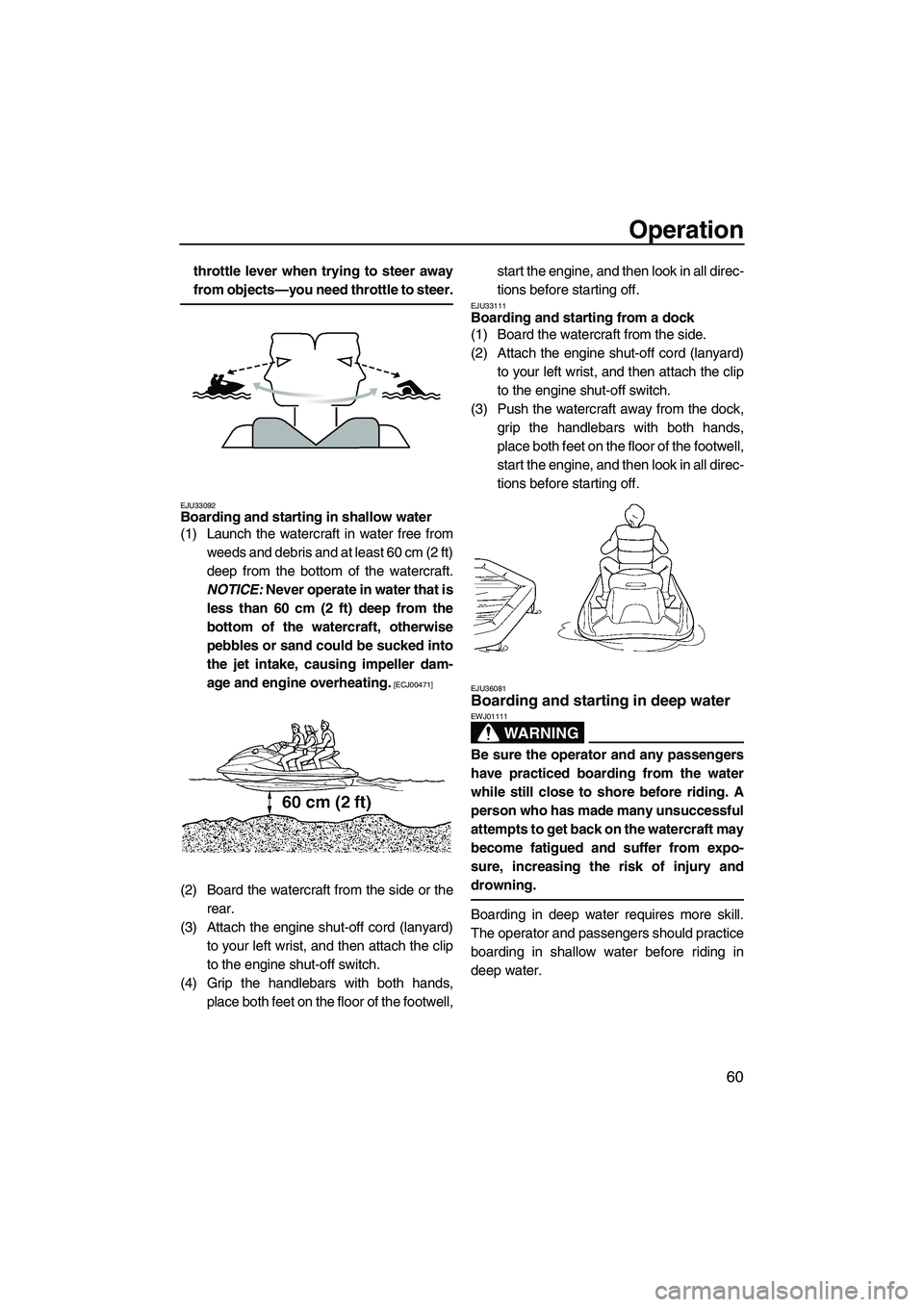
Operation
60
throttle lever when trying to steer away
from objects—you need throttle to steer.
EJU33092Boarding and starting in shallow water
(1) Launch the watercraft in water free from
weeds and debris and at least 60 cm (2 ft)
deep from the bottom of the watercraft.
NOTICE: Never operate in water that is
less than 60 cm (2 ft) deep from the
bottom of the watercraft, otherwise
pebbles or sand could be sucked into
the jet intake, causing impeller dam-
age and engine overheating.
[ECJ00471]
(2) Board the watercraft from the side or the
rear.
(3) Attach the engine shut-off cord (lanyard)
to your left wrist, and then attach the clip
to the engine shut-off switch.
(4) Grip the handlebars with both hands,
place both feet on the floor of the footwell,start the engine, and then look in all direc-
tions before starting off.
EJU33111Boarding and starting from a dock
(1) Board the watercraft from the side.
(2) Attach the engine shut-off cord (lanyard)
to your left wrist, and then attach the clip
to the engine shut-off switch.
(3) Push the watercraft away from the dock,
grip the handlebars with both hands,
place both feet on the floor of the footwell,
start the engine, and then look in all direc-
tions before starting off.
EJU36081Boarding and starting in deep water
WARNING
EWJ01111
Be sure the operator and any passengers
have practiced boarding from the water
while still close to shore before riding. A
person who has made many unsuccessful
attempts to get back on the watercraft may
become fatigued and suffer from expo-
sure, increasing the risk of injury and
drowning.
Boarding in deep water requires more skill.
The operator and passengers should practice
boarding in shallow water before riding in
deep water.
UF2C70E0.book Page 60 Monday, November 3, 2008 10:16 AM
Page 68 of 98
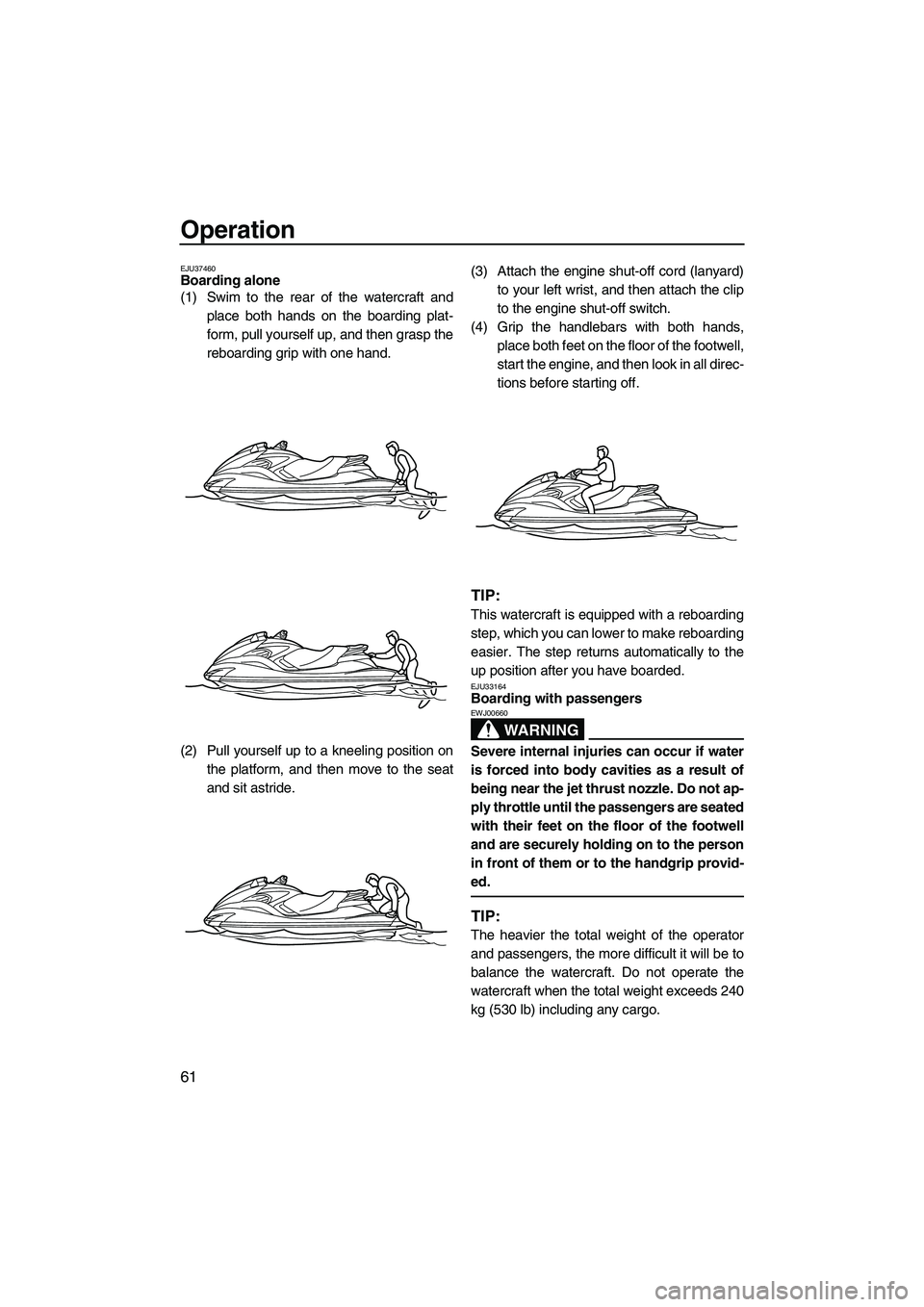
Operation
61
EJU37460Boarding alone
(1) Swim to the rear of the watercraft and
place both hands on the boarding plat-
form, pull yourself up, and then grasp the
reboarding grip with one hand.
(2) Pull yourself up to a kneeling position on
the platform, and then move to the seat
and sit astride.(3) Attach the engine shut-off cord (lanyard)
to your left wrist, and then attach the clip
to the engine shut-off switch.
(4) Grip the handlebars with both hands,
place both feet on the floor of the footwell,
start the engine, and then look in all direc-
tions before starting off.
TIP:
This watercraft is equipped with a reboarding
step, which you can lower to make reboarding
easier. The step returns automatically to the
up position after you have boarded.
EJU33164Boarding with passengers
WARNING
EWJ00660
Severe internal injuries can occur if water
is forced into body cavities as a result of
being near the jet thrust nozzle. Do not ap-
ply throttle until the passengers are seated
with their feet on the floor of the footwell
and are securely holding on to the person
in front of them or to the handgrip provid-
ed.
TIP:
The heavier the total weight of the operator
and passengers, the more difficult it will be to
balance the watercraft. Do not operate the
watercraft when the total weight exceeds 240
kg (530 lb) including any cargo.
UF2C70E0.book Page 61 Monday, November 3, 2008 10:16 AM
Page 69 of 98
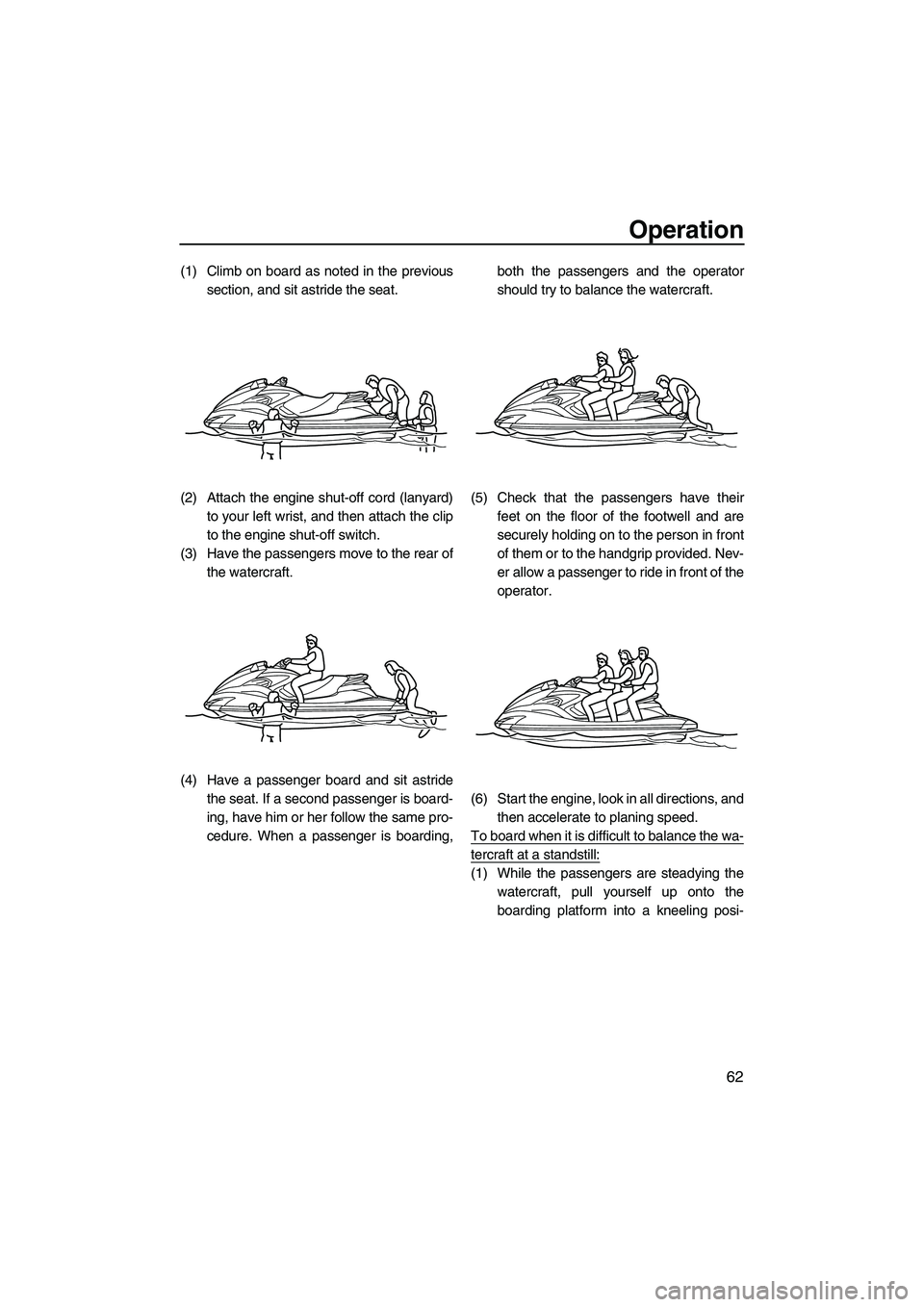
Operation
62
(1) Climb on board as noted in the previous
section, and sit astride the seat.
(2) Attach the engine shut-off cord (lanyard)
to your left wrist, and then attach the clip
to the engine shut-off switch.
(3) Have the passengers move to the rear of
the watercraft.
(4) Have a passenger board and sit astride
the seat. If a second passenger is board-
ing, have him or her follow the same pro-
cedure. When a passenger is boarding,both the passengers and the operator
should try to balance the watercraft.
(5) Check that the passengers have their
feet on the floor of the footwell and are
securely holding on to the person in front
of them or to the handgrip provided. Nev-
er allow a passenger to ride in front of the
operator.
(6) Start the engine, look in all directions, and
then accelerate to planing speed.
To board when it is difficult to balance the wa-
tercraft at a standstill:
(1) While the passengers are steadying the
watercraft, pull yourself up onto the
boarding platform into a kneeling posi-
UF2C70E0.book Page 62 Monday, November 3, 2008 10:16 AM
Page 70 of 98
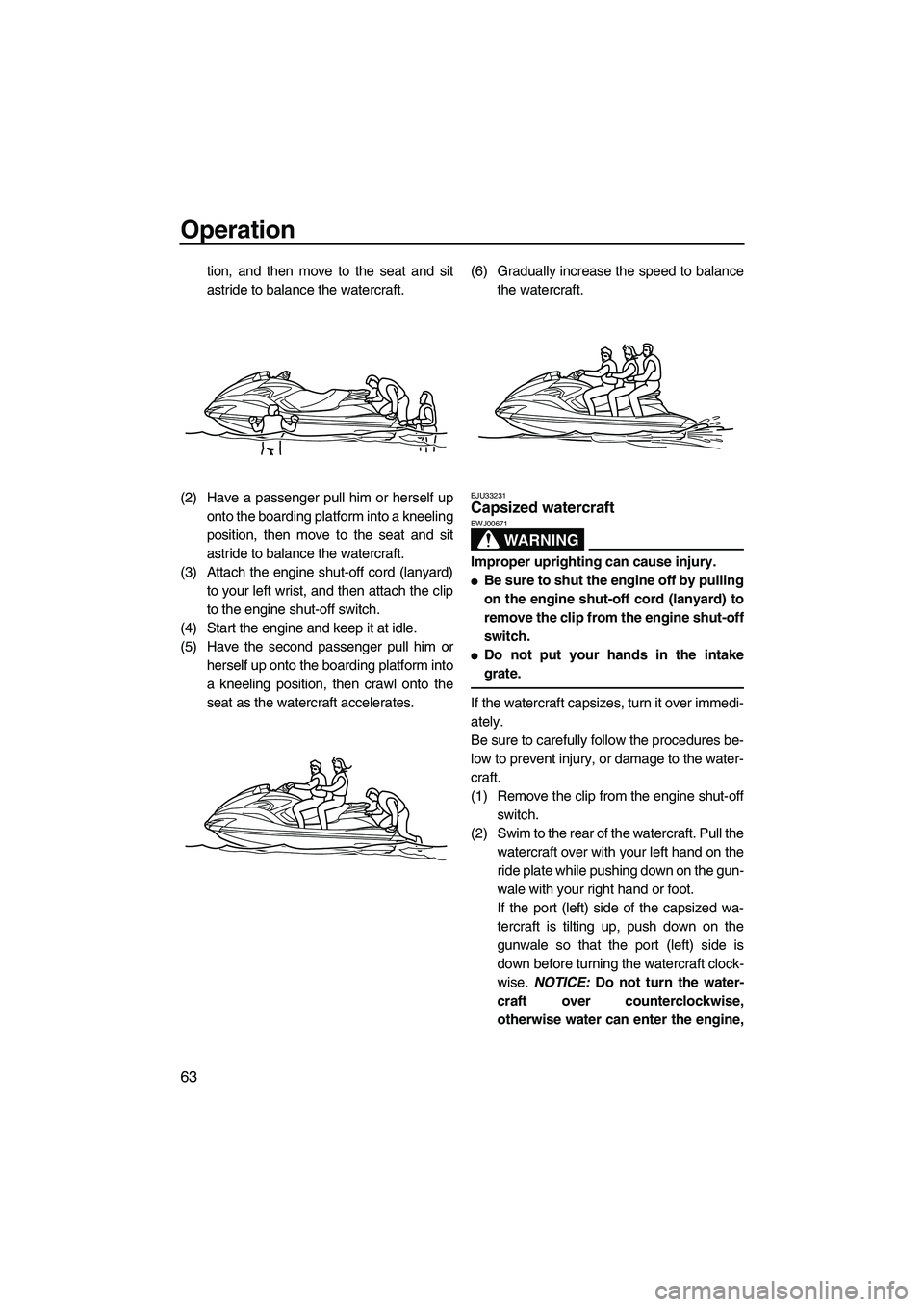
Operation
63
tion, and then move to the seat and sit
astride to balance the watercraft.
(2) Have a passenger pull him or herself up
onto the boarding platform into a kneeling
position, then move to the seat and sit
astride to balance the watercraft.
(3) Attach the engine shut-off cord (lanyard)
to your left wrist, and then attach the clip
to the engine shut-off switch.
(4) Start the engine and keep it at idle.
(5) Have the second passenger pull him or
herself up onto the boarding platform into
a kneeling position, then crawl onto the
seat as the watercraft accelerates.(6) Gradually increase the speed to balance
the watercraft.
EJU33231Capsized watercraft
WARNING
EWJ00671
Improper uprighting can cause injury.
�Be sure to shut the engine off by pulling
on the engine shut-off cord (lanyard) to
remove the clip from the engine shut-off
switch.
�Do not put your hands in the intake
grate.
If the watercraft capsizes, turn it over immedi-
ately.
Be sure to carefully follow the procedures be-
low to prevent injury, or damage to the water-
craft.
(1) Remove the clip from the engine shut-off
switch.
(2) Swim to the rear of the watercraft. Pull the
watercraft over with your left hand on the
ride plate while pushing down on the gun-
wale with your right hand or foot.
If the port (left) side of the capsized wa-
tercraft is tilting up, push down on the
gunwale so that the port (left) side is
down before turning the watercraft clock-
wise. NOTICE: Do not turn the water-
craft over counterclockwise,
otherwise water can enter the engine,
UF2C70E0.book Page 63 Monday, November 3, 2008 10:16 AM
Page 71 of 98
![YAMAHA FZS 2009 Owners Manual Operation
64
which can result in severe damage.
[ECJ00541]
(3) Start the engine and operate the water-
craft as straight as possible and above
planing speed for at least 2 minutes to
discharge any wat YAMAHA FZS 2009 Owners Manual Operation
64
which can result in severe damage.
[ECJ00541]
(3) Start the engine and operate the water-
craft as straight as possible and above
planing speed for at least 2 minutes to
discharge any wat](/manual-img/51/50223/w960_50223-70.png)
Operation
64
which can result in severe damage.
[ECJ00541]
(3) Start the engine and operate the water-
craft as straight as possible and above
planing speed for at least 2 minutes to
discharge any water remaining in the en-
gine compartment. (If the engine does
not start, see “Towing the watercraft” on
page 88 or “Submerged watercraft” on
page 88.) NOTICE: Do not operate the
engine at full throttle for at least 1
minute after the engine has been re-
started. Excessive water in the engine
compartment can splash into the en-
gine, which can result in severe dam-
age.
[ECJ00551]
EJU33251
Turning the watercraft
WARNING
EWJ00770
�Do not release the throttle lever when
trying to steer away from objects—youneed throttle to steer. A collision could
result in severe injury or death.
�When operating at higher speeds, make
gradual turns or slow down before turn-
ing. Sharp high-speed turns may cause
the watercraft to slide sideways or spin,
throwing the operator and passengers
overboard, which could cause an injury.
Steering control depends on the combination
of handlebar position and the amount of throt-
tle.
Water sucked in through the intake grate is
pressurized by the impeller in the jet pump. As
the pressurized water is expelled from the
pump through the jet thrust nozzle, it creates
thrust to move and steer the watercraft. The
higher the engine speed, the more thrust pro-
duced.
The amount of jet thrust, in addition to the po-
sition of the handlebars, determines how
sharply you turn.
A. More throttle produces higher thrust, so
the watercraft will turn more sharply.
UF2C70E0.book Page 64 Monday, November 3, 2008 10:16 AM
Page 72 of 98
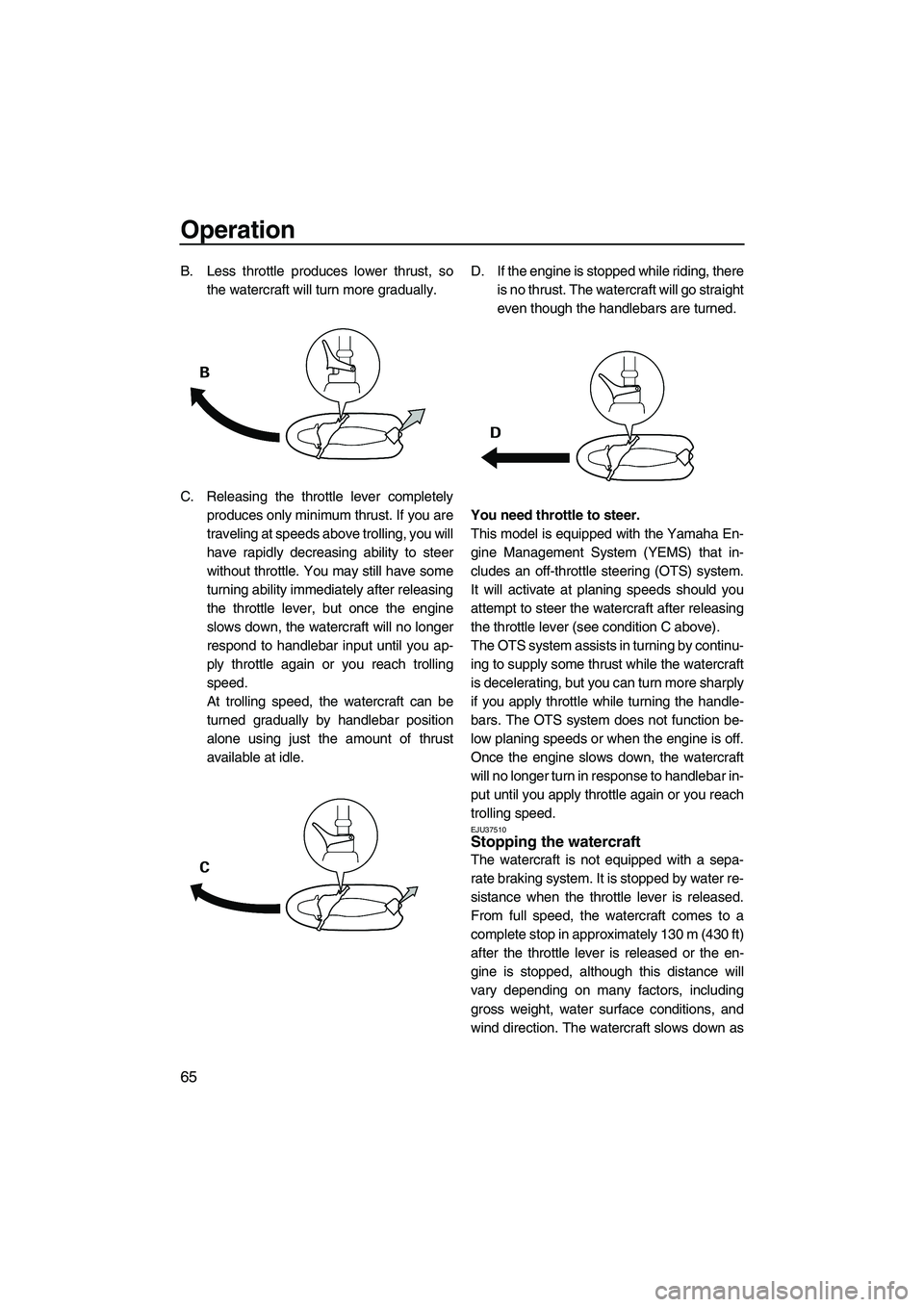
Operation
65
B. Less throttle produces lower thrust, so
the watercraft will turn more gradually.
C. Releasing the throttle lever completely
produces only minimum thrust. If you are
traveling at speeds above trolling, you will
have rapidly decreasing ability to steer
without throttle. You may still have some
turning ability immediately after releasing
the throttle lever, but once the engine
slows down, the watercraft will no longer
respond to handlebar input until you ap-
ply throttle again or you reach trolling
speed.
At trolling speed, the watercraft can be
turned gradually by handlebar position
alone using just the amount of thrust
available at idle.D. If the engine is stopped while riding, there
is no thrust. The watercraft will go straight
even though the handlebars are turned.
You need throttle to steer.
This model is equipped with the Yamaha En-
gine Management System (YEMS) that in-
cludes an off-throttle steering (OTS) system.
It will activate at planing speeds should you
attempt to steer the watercraft after releasing
the throttle lever (see condition C above).
The OTS system assists in turning by continu-
ing to supply some thrust while the watercraft
is decelerating, but you can turn more sharply
if you apply throttle while turning the handle-
bars. The OTS system does not function be-
low planing speeds or when the engine is off.
Once the engine slows down, the watercraft
will no longer turn in response to handlebar in-
put until you apply throttle again or you reach
trolling speed.
EJU37510Stopping the watercraft
The watercraft is not equipped with a sepa-
rate braking system. It is stopped by water re-
sistance when the throttle lever is released.
From full speed, the watercraft comes to a
complete stop in approximately 130 m (430 ft)
after the throttle lever is released or the en-
gine is stopped, although this distance will
vary depending on many factors, including
gross weight, water surface conditions, and
wind direction. The watercraft slows down as
UF2C70E0.book Page 65 Monday, November 3, 2008 10:16 AM